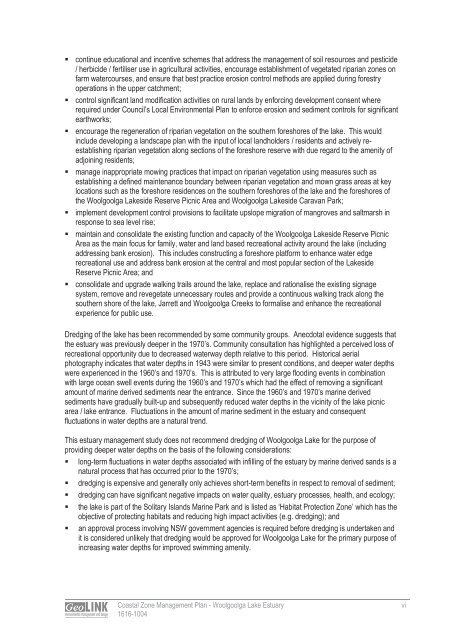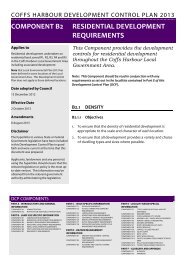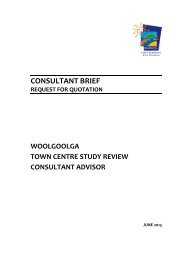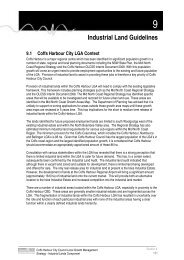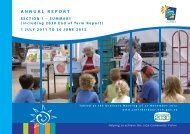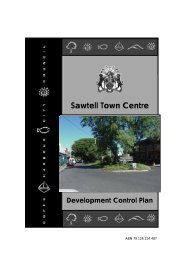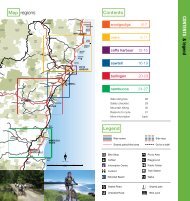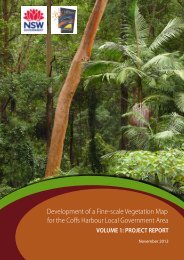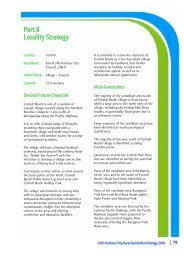Woolgoolga Lake Estuary Coastal Zone Management Plan (7.9MB)
Woolgoolga Lake Estuary Coastal Zone Management Plan (7.9MB)
Woolgoolga Lake Estuary Coastal Zone Management Plan (7.9MB)
Create successful ePaper yourself
Turn your PDF publications into a flip-book with our unique Google optimized e-Paper software.
continue educational and incentive schemes that address the management of soil resources and pesticide/ herbicide / fertiliser use in agricultural activities, encourage establishment of vegetated riparian zones onfarm watercourses, and ensure that best practice erosion control methods are applied during forestryoperations in the upper catchment; control significant land modification activities on rural lands by enforcing development consent whererequired under Council’s Local Environmental <strong>Plan</strong> to enforce erosion and sediment controls for significantearthworks; encourage the regeneration of riparian vegetation on the southern foreshores of the lake. This wouldinclude developing a landscape plan with the input of local landholders / residents and actively reestablishingriparian vegetation along sections of the foreshore reserve with due regard to the amenity ofadjoining residents; manage inappropriate mowing practices that impact on riparian vegetation using measures such asestablishing a defined maintenance boundary between riparian vegetation and mown grass areas at keylocations such as the foreshore residences on the southern foreshores of the lake and the foreshores ofthe <strong>Woolgoolga</strong> <strong>Lake</strong>side Reserve Picnic Area and <strong>Woolgoolga</strong> <strong>Lake</strong>side Caravan Park; implement development control provisions to facilitate upslope migration of mangroves and saltmarsh inresponse to sea level rise; maintain and consolidate the existing function and capacity of the <strong>Woolgoolga</strong> <strong>Lake</strong>side Reserve PicnicArea as the main focus for family, water and land based recreational activity around the lake (includingaddressing bank erosion). This includes constructing a foreshore platform to enhance water edgerecreational use and address bank erosion at the central and most popular section of the <strong>Lake</strong>sideReserve Picnic Area; and consolidate and upgrade walking trails around the lake, replace and rationalise the existing signagesystem, remove and revegetate unnecessary routes and provide a continuous walking track along thesouthern shore of the lake, Jarrett and <strong>Woolgoolga</strong> Creeks to formalise and enhance the recreationalexperience for public use.Dredging of the lake has been recommended by some community groups. Anecdotal evidence suggests thatthe estuary was previously deeper in the 1970’s. Community consultation has highlighted a perceived loss ofrecreational opportunity due to decreased waterway depth relative to this period. Historical aerialphotography indicates that water depths in 1943 were similar to present conditions, and deeper water depthswere experienced in the 1960’s and 1970’s. This is attributed to very large flooding events in combinationwith large ocean swell events during the 1960’s and 1970’s which had the effect of removing a significantamount of marine derived sediments near the entrance. Since the 1960’s and 1970’s marine derivedsediments have gradually built-up and subsequently reduced water depths in the vicinity of the lake picnicarea / lake entrance. Fluctuations in the amount of marine sediment in the estuary and consequentfluctuations in water depths are a natural trend.This estuary management study does not recommend dredging of <strong>Woolgoolga</strong> <strong>Lake</strong> for the purpose ofproviding deeper water depths on the basis of the following considerations: long-term fluctuations in water depths associated with infilling of the estuary by marine derived sands is anatural process that has occurred prior to the 1970’s; dredging is expensive and generally only achieves short-term benefits in respect to removal of sediment; dredging can have significant negative impacts on water quality, estuary processes, health, and ecology; the lake is part of the Solitary Islands Marine Park and is listed as ‘Habitat Protection <strong>Zone</strong>’ which has theobjective of protecting habitats and reducing high impact activities (e.g. dredging); and an approval process involving NSW government agencies is required before dredging is undertaken andit is considered unlikely that dredging would be approved for <strong>Woolgoolga</strong> <strong>Lake</strong> for the primary purpose ofincreasing water depths for improved swimming amenity.<strong>Coastal</strong> <strong>Zone</strong> <strong>Management</strong> <strong>Plan</strong> - <strong>Woolgoolga</strong> <strong>Lake</strong> <strong>Estuary</strong>1616-1004vi


